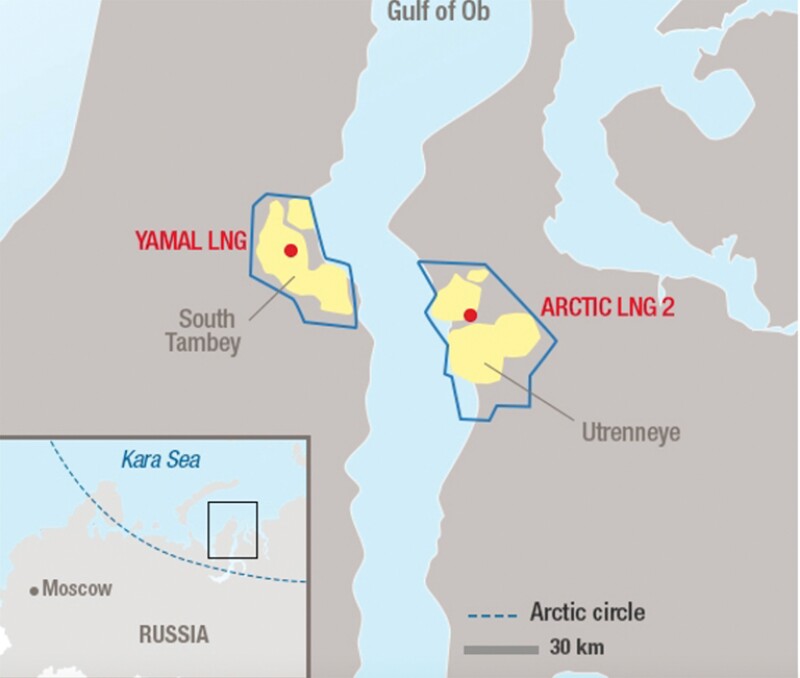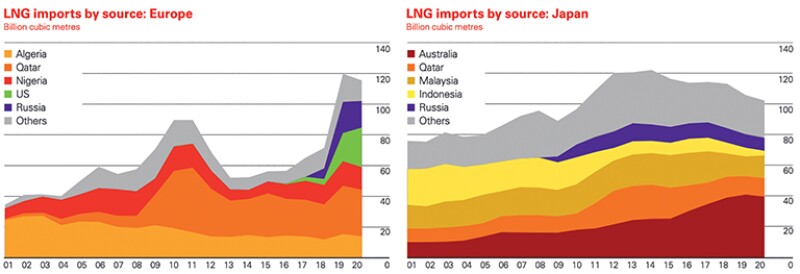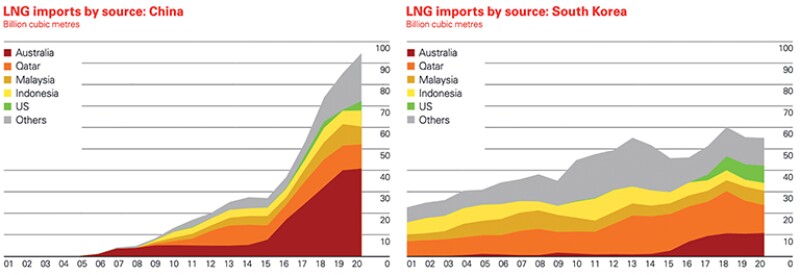Russia’s market influence as an exporter of liquefied natural gas (LNG) is growing, possessing the world’s largest reserves of natural gas and the logistical options to deliver it at competitive prices to Asia and Europe along the now-navigable Northern Sea Route (NSR).
The country became a player in the LNG market when it shipped its first cargo in 2009 to Japan from what was then Russia’s first offshore gas project, Sakhalin-2 in the Far East, operated by Sakhalin Energy Investment Company Ltd. and owned by Russia’s pipeline gas monopoly Gazprom (50% plus one share), Shell (27.5% minus one share), and Japan’s Mitsui (12.5%) and Mitsubishi (10%).
Sakhalin Energy operates three oil and gas platforms producing its current resource base from the Piltun-Astokhskoye oil field and the Lunskoye gas field off the northeastern coast of Sakhalin.
To date, Sakhalin Energy has sold all the LNG produced at its 11.49-mtpa-capacity Prigorodnoye LNG production complex on the southern tip of Sakhalin Island, under long-term contracts to buyers in the Asia Pacific and North America, according to Shell’s website.
In 2024–2026, the partners say they will add a third train to expand capacity by 5.4 mtpa, though they have repeatedly delayed this expansion for years due to a lack of investment capital to develop a new resource base and low gas prices in Asia. The same holds true for Gazprom’s plan for an LNG plant near Vladivostok.
However, the market has now changed with rising demand for gas to replace coal, giving gas producers an incentive to invest into new E&P gas projects and mid-to-downstream megaprojects like those for producing LNG.
In 2018 and again this past January, European spot gas prices spiked on Gasunie’s leading TTF (title transfer facility) virtual trading platform and other European trading hubs when Asian gas markets began offering high premiums to divert LNG cargos from Europe, according to the EU Commission’s latest European Gas Market report.
The Rise of a Russian IOC—Novatek in Yamal
Russia’s largest independent natural gas producer Novatek was Russia’s second entrant into the LNG market when its Yamal LNG project rose above the permafrost atop an estimated 65,000 piles on the Yamal Peninsula, home to Russia’s largest gas deposits and the source of Russian pipeline gas sold into Europe.
Yamal LNG shipped its first cargo (170000 m3) in December 2017.
It then upped the ante with exports from a second train in August 2018, and added a third train in November 2018, according to Novatek’s website. Situated on the South Tambeyskoye field on the coast of Ob Bay, the plant boasts a capacity of 17.4 mtpa.
Yamal LNG’s partners in the northwest Siberian project include Novatek (50.1%), TotalEnergies (20%), CNPC (20%), and the Silk Road Fund (9.9%).
BP’s 2020 Statistical Review of World Energy shines a spotlight on Russia’s rapid climb up the LNG learning curve that coincided with Novatek’s entrance into the market.
Russia’s LNG exports jumped 38% to 24.9 Bcm of gas in 2018 when compared to the 15.4 Bcm it exported in 2017, reflecting the impact of Yamal LNG having commissioned its first three trains. In 2019, Russian LNG exports jumped again, by 36% to 39.1 Bcm of gas for the year, according to the BP report.
In 2020, Russia’s LNG exports hit 40.4 Bcm of gas, a nearly threefold increase since 2010.
To put this in perspective, with Sakhalin-2 as its only player in the game, Russia exported 13.5 Bcm of gas as LNG in 2010, inching up to only 15.4 Bcm by 2017. But when Yamal LNG went onstream a year later with a capacity 33% higher than Sakhalin-2, the numbers changed radically.
With its aim to grow its LNG business to 70 mtpa by 2030, Novatek is fast-tracking expansion plans to nearly quadruple capacity, Mark Gyetvay, deputy chairman of the company’s management board, said in a recent podcast interview with Natural Gas World (NGW).
Yamal LNG has been operating in excess of its 110% nameplate capacity and has shipped 700 cargos so far, after having passed the 500-cargo mark in record time, Gyetvay said.
He outlined the following steps the company is taking to reach its goal:
- Launch production at Novatek’s $21 billion Arctic LNG-2 facility in 2023 and reach full capacity of 19.8 mtpa (three trains at 6.6 mtpa each) by 2026. Arctic LNG-2 is being constructed on the Gydan Peninsula across Ob Bay from Yamal LNG on the Yamal Peninsula (Fig. 1).
- Continue exploration drilling and running of 3D seismic to define the resource base for Arctic LNG-1, followed by negotiation of farmouts with potential partners. Arctic LNG-1 and Arctic LNG-3 (which is in an even earlier exploration phase) will each have a capacity of 19.8 mtpa.
- Testing over 12 to 18 months of Novatek’s proprietary “Arctic Cascade” liquefication technology at a 0.9 mtpa fourth train commissioned in January at Yamal LNG. The process uses ambient Arctic temperatures as part of the liquefaction process to lower energy consumption and capital costs.
- Fabrication of gravity-based structures (GBS) to support the installation of trains and other relevant facilities above the permafrost. GBS is preferred over traditional piles for their smaller footprint. Houston-based EPCI service provider McDermott International announced that its Chinese joint venture Qingdao McDermott Wuchuan Offshore Engineering won the contract to provide three GBS modules for Arctic LNG-2 by mid 2022.
- With work on Arctic LNG-2 well under way, Novatek will make a final investment decision (FID) on Arctic LNG-1 in 2023 or 2024, with construction expected to start in 2026 or 2027; Arctic LNG-3 will see construction in the 2030s, Gyetvay noted in the podcast.

Novatek is also raising $100 billion in third-party finance by pledging its 60% stake Arctic LNG-2 as collateral, a move that has quickly attracted pledges from banks and financial institutions in Germany, France, China, Japan, Italy, and Russia.
Novatek’s partners in Arctic LNG-2 hold a 40% stake split equally among France’s TotalEnergies, the China National Petroleum Corporation, China’s CNOOC, and the Japan Arctic LNG consortium, made up of Mitsui & Co. and state-owned JOGMEC, formally known as Japan Oil, Gas, and Metals National Corp.
12-Month Arctic Sea Shipping Opens New Options
Nature meanwhile has been the biggest game changer to boost Russia’s position as an LNG supplier. In January 2021, the Russian Arctic-class LNG carrier Christophe de Margerie completed the first-ever round trip along the NSR from the Kara Sea to China, proving that year-round navigation is possible.
So far, Europe has been the principal buyer of Russian LNG from the Yamal Peninsula, while Japan is the primary destination of Sakhalin-2 LNG in the Far East (with some cargos going to South Korea and North America) (Figs. 2 and 3).


Now however, year-round shipping along Russia’s Arctic Sea coast puts China in reach and makes LNG from northwest Siberia more competitive on price with cargos from Qatar, Australia, and Indonesia in the Asia Pacific.
Vessels carrying LNG from Yamal along the NSR reach Asia in 15 days via the Bering Strait, half the time the journey would take via the Suez Canal, according to TotalEnergies. In June, the company bought a 10% stake in the Novatek subsidiary Arctic Transshipment LLC which is developing transshipment hubs in Murmansk for westbound transit and Kamchatka for eastbound transit (Fig. 4).

Initially, both terminals will be equipped with a 360000 m3 floating storage unit (FSU) and two ship-to-ship transfer kits (STS) for providing export logistics services, TotalEnergies noted on its website.
This will enable Arc7 ice-class LNG carriers to transport cargos through Arctic Ocean ice and then offload onto conventional LNG carriers which will carry the LNG further to its destination. Limiting the use of Arc7 ice-class LNG carriers optimizes logistics, cuts cost, and reduces CO2 emissions, TotalEnergies said.
Russia and the US Wage a Gas War in Europe
The EU is the world’s third-largest LNG market, though its imports amounted to only about half that of Japan (36 Bcm) and China (32 Bcm) in Q1 2021, according to the EU Commission’s latest Quarterly Report on European Gas Markets.
In Europe, Russia competes head on with the US which emerged as the EU’s top LNG supplier in Q4 2019 when competition between the two former Cold War rivals became heated and imports from Qatar tumbled to third place.
Also, because Europe is the world’s-largest gas market with active gas-on-gas competition between pipeline gas imports and LNG, it is likely that Gazprom’s influence in Europe’s energy mix may start to diminish over time.
In the future, Europe may still import mostly Russian gas molecules, but they could just as likely come from LNG produced by Novatek or state oil company Rosneft as they could from pipeline gas from Gazprom, considering Gazprom’s monopoly stems from its control of Russia’s gas export pipeline system.
It is worth noting that the US can be expected to strongly defend its position as Europe’s top LNG supplier, given that the logistics of shipping US LNG to Europe are likely to yield more profitable sales there, compared to sales to Asia (Fig. 4).
LNG opens the door to other Russian companies besides Gazprom to sell their gas for export, a fact that has not been lost on Russia’s other energy behemoth, Rosneft, which has long sought an opportunity to export its gas.
In March, Rosneft announced it would shed underperforming brownfield assets to raise capital to transform itself into an LNG player.
Several months earlier, Rosneft CEO Igor Sechin had articulated his company’s vision to produce LNG in 6 to 8 years using gas from its Vostok field on the Kara Sea coast, not far from Novatek’s operations.
BP acquired a 19.75% stake in Rosneft in 2013 when it sold its 50% interest in the TNK-BP joint venture to the Russian major. BP holds two seats on Rosneft's board of directors and in 2017, the companies signed a memorandum of understanding to establish a "strategic gas partnership" to develop joint gas projects in and outside of Russia, including those in LNG, according to BP's website.
In the Far East, Rosneft is working with ExxonMobil, its partner in Sakhalin-1, to make real their long-anticipated Russia Far East LNG (RFE LNG) project to monetize gas from the Sakhalin-1 PSA. Sakhalin-1 co-ventures have awarded the front-end engineering and design (FEED) contract to Houston’s TechnipFMC, according to ExxonMobil’s website.
Exxon Neftegas Limited (ENL) operates Sakhalin-1 and holds a 30% stake in association with Japan’s SODECO Consortium (30%), India’s ONGC Videsh (20%) and two Rosneft affiliates, RN-Astra (8.5%) and Sakhalinmorneftegaz-Shelf (11.5%).
The proposed RFE LNG project envisions a 6.2-mtpa LNG plant to be sited near Sakhalin-1’s existing De-Kastri oil export terminal in Khabarovsk Krai on the Russian mainland. ExxonMobil’s site notes that a final investment decision will be made “in due course.”
Gas: Transition Fuel or Critical to Energy Mix?
BP’s World Energy 2020 noted that even though the pandemic caused demand for gas to decline in absolute terms in 2020, the share of gas in the primary energy mix has continued to rise, reaching a record high of 24.7% globally.
In its LNG Outlook 2021, Shell noted that China and India led the post-pandemic recovery in demand for LNG, each increasing their imports by 11%.
Forecasts expect global LNG demand to reach 700 mtpa by 2040, as demand for gas grows in Asia and becomes a fuel of choice in some hard-to-electrify sectors, according to the same report.
As a result, the report concluded, LNG suppliers will be investing more to ensure there is no shortage of supply as demand continues to rise, a situation that could occur as early as the mid-2020s.
Proponents of green energy, particularly in Europe, have argued that gas is a transition fuel that will be phased out of the energy mix gradually and replaced by renewables—but not all in the energy industry agree.
“Novatek’s pathway forward to decarbonization is to sell more gas, not less,” Novatek’s Gyetvey said in his interview, predicting that gas will account for up to 28% of any future energy mix, with renewables and hydrogen also playing a part.
“But to say that no new investments are needed [in fossil fuels] post-2021 … you’ll see by the end of this year. You’ll see the IOCs, you’ll see Novatek, you’ll see other Russian oil and gas companies come out with their Capex programs,” he said, “and it’s going to show how totally ridiculous this comment [on investment] had been.”


